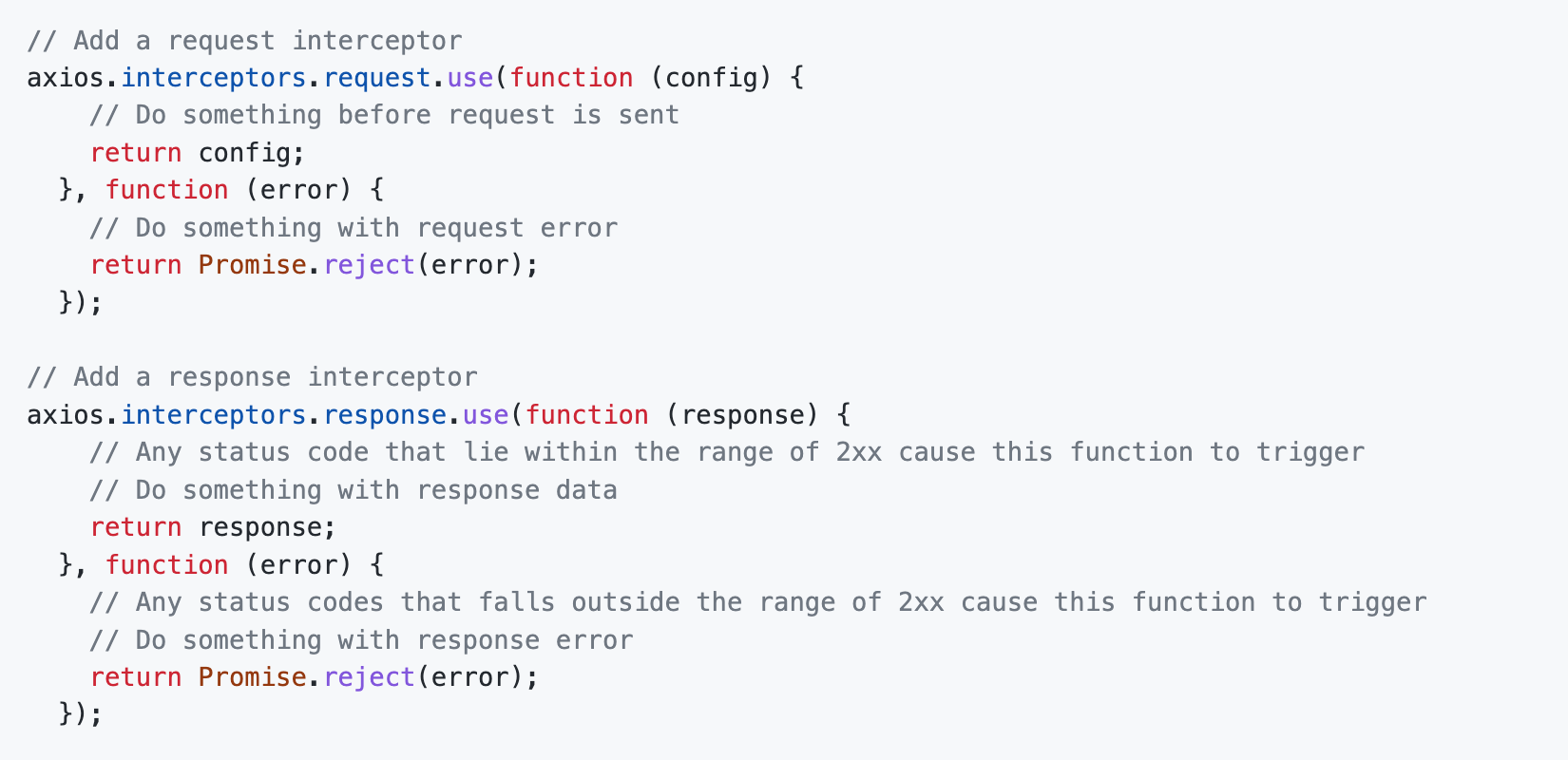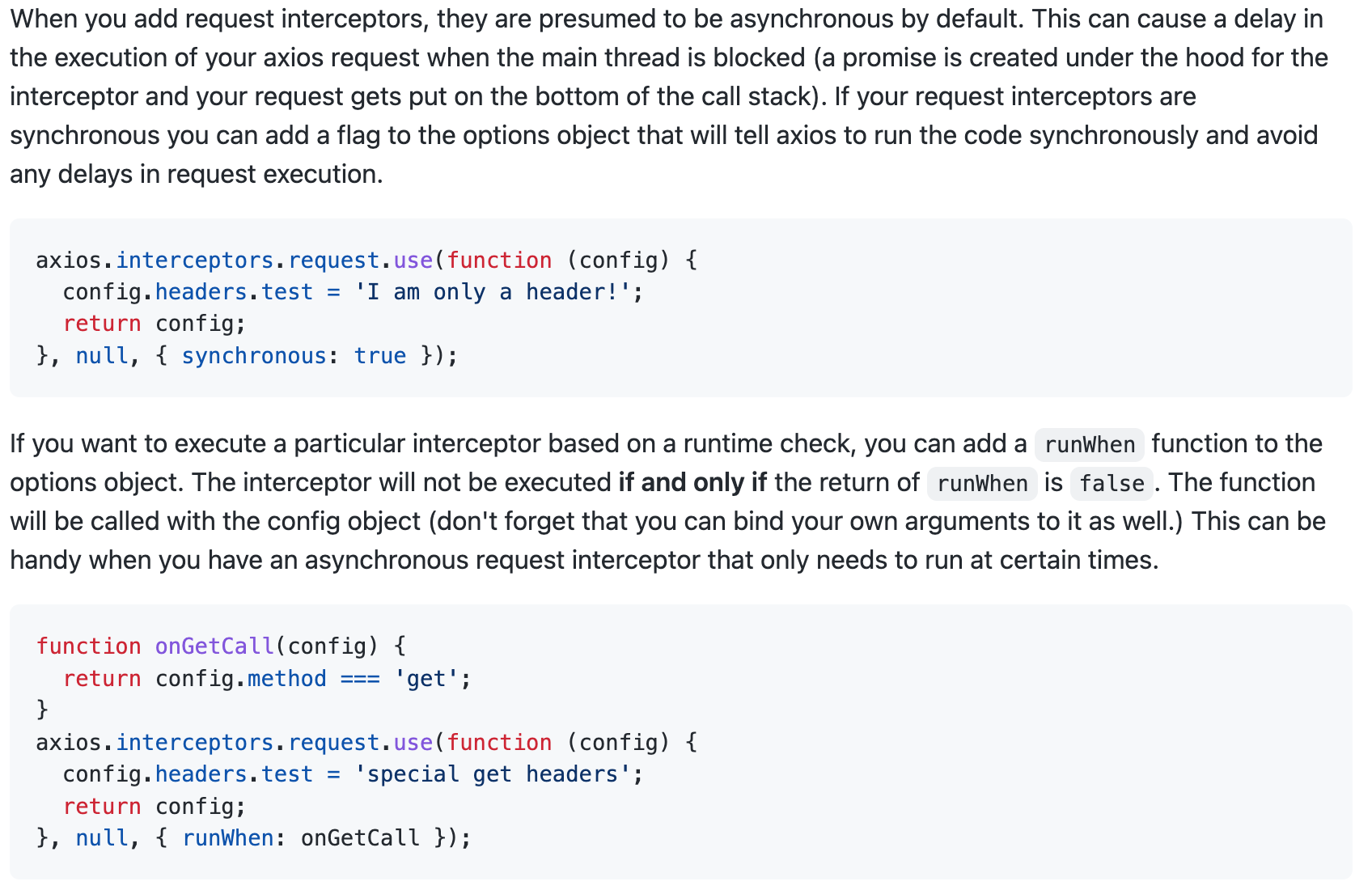上一篇,我们扩展了Axios,构建了一个Axios类,然后通过这个Axios工厂类,创建真正的axios实例。那么今天,我们来实现下Axios的拦截器也就是interceptors。我们来简单看下Axios的interceptors的API:

首先我们来看,axios上有一个interceptors属性,该属性上还有两个属性,分别对应request和response,并且都有一个一样的use方法,该方法目前有两个参数,分别对应着Promise中的resolve和reject。

另外,你还可以通过对应拦截器的eject方法,移除某个拦截器。

最后,我们还可以通过配置第三个参数,确定执行拦截器的条件、是否异步等。最后的最后,我们还需要知道拦截器的执行顺序,我们先来看一段代码:
axios.interceptors.request.use((config) => { config.headers.test += "1"; return config; }); axios.interceptors.request.use((config) => { config.headers.test += "2"; return config; }); axios.interceptors.request.use((config) => { config.headers.test += "3"; return config; }); axios.interceptors.response.use((res) => { res.data += "1"; return res; }); let c5 = axios.interceptors.response.use((res) => { res.data += "2"; return res; }); axios.interceptors.response.use((res) => { res.data += "3"; return res; }); axios.interceptors.response.eject(c5); axios({ url: "/c5/get", method: "get", headers: { test: "", }, }).then((res) => { console.log(res.data); });
这是我们最终demo里的代码,它的结果是什么样子呢?我得在这里就给出大家答案,不然有个核心的点大家可能就不理解了。其中request的header中的tes的值是321,打印的response的结果是13。OK,依照此我们可以得出结论,就是越靠近请求的拦截器越先执行,什么意思呢?就是我们文档流中写在后面的请求拦截器最先执行,写在前面的响应拦截器最先执行。它是一种以中心向外散射的一种模型。
那么我们接下来看怎么来实现这个拦截器吧:
"use strict"; import utils from "./../utils"; function InterceptorManager() { this.handlers = []; } /** * Add a new interceptor to the stack * * @param {Function} fulfilled The function to handle `then` for a `Promise` * @param {Function} rejected The function to handle `reject` for a `Promise` * * @return {Number} An ID used to remove interceptor later */ InterceptorManager.prototype.use = function use(fulfilled, rejected, options) { this.handlers.push({ fulfilled: fulfilled, rejected: rejected, synchronous: options ? options.synchronous : false, runWhen: options ? options.runWhen : null, }); return this.handlers.length - 1; }; /** * Remove an interceptor from the stack * * @param {Number} id The ID that was returned by `use` */ InterceptorManager.prototype.eject = function eject(id) { if (this.handlers[id]) { this.handlers[id] = null; } }; /** * Iterate over all the registered interceptors * * This method is particularly useful for skipping over any * interceptors that may have become `null` calling `eject`. * * @param {Function} fn The function to call for each interceptor */ InterceptorManager.prototype.forEach = function forEach(fn) { utils.forEach(this.handlers, function forEachHandler(h) { if (h !== null) { fn(h); } }); }; export default InterceptorManager;
首先,我们在core文件夹下创建一个InterceptorManager.js,代码如上,在文件内我们构建一个InterceptorManager类,这个类上只有一个数组作为存储具体拦截器的容器。
然后呢,我们在它的原型上挂载一个use方法,这个前面说过了,就是要把具体的拦截器放置到容器内,以待最后的使用,其中放置的是一个包含了resolve和reject函数以及两个参数的对象,这个方法返回了一个对应拦截器在容器内的下标作为id。
再然后呢,就是一个eject方法,使用use方法中返回的下标,直接设置为null即可,提问!为啥这里不直接移除(splice啥的)容器内的拦截器,而是把对应位置的拦截器设置为null呢?
最后,我们提供一个forEach方法,循环执行容器内的拦截器即可。那么到现在为止,整个拦截器管理类就实现了。下面我们看看如何使用。
Axios.prototype.request = function (configOrUrl, config) { if (typeof configOrUrl === "string") { if (!config) { config = {}; } config.url = configOrUrl; } else { config = configOrUrl; } // 请求拦截器调用链 var requestInterceptorChain = []; // 是否同步 var synchronousRequestInterceptors = true; // 通过拦截器的forEach方法,通过回调函数的方式,把所有的请求拦截放到requestInterceptorChain数组里 this.interceptors.request.forEach(function unshiftRequestInterceptors( interceptor ) { if ( // 判断下如果runWhen是false就return掉了 typeof interceptor.runWhen === "function" && interceptor.runWhen(config) === false ) { return; } // 判断是否是同步执行 synchronousRequestInterceptors = synchronousRequestInterceptors && interceptor.synchronous; // 把两个回调函数放到数组的头部 // 注意这里不是unshift一个数组,而是独立的,就是这样[interceptor.fulfilled,interceptor.rejected] // [3,2,1] requestInterceptorChain.unshift( interceptor.fulfilled, interceptor.rejected ); }); // 响应拦截器调用链 var responseInterceptorChain = []; // response这个比较简单,直接push进数组就完事了 this.interceptors.response.forEach(function pushResponseInterceptors( interceptor ) { responseInterceptorChain.push(interceptor.fulfilled, interceptor.rejected); }); // 定一个promise变量,后面用 var promise; // 如果不是同步的 if (!synchronousRequestInterceptors) { var chain = [dispatchRequest, undefined]; // 这块呢,就把整个requestInterceptorChain放到chain的前面 Array.prototype.unshift.apply(chain, requestInterceptorChain); // 这个就是把responseInterceptorChain放到[requestInterceptorChain,chain]后面 chain = chain.concat(responseInterceptorChain); // 额外要说的是到了这里,这个chain数组是什么样的呢 // 我们打印下,以我们之前的例子代码为例: // 它实际上是这样的[fn,undefined,fn,undefined,fn,undefined,fn,undefined,fn,undefined,fn,undefined] // 具体点,[requestInterceptorChain,chain,responseInterceptorChain] // 再具体点:[requestResolve3,undefined,requestResolve2,undefined,requestResolve1,undefined,dispatchRequest, undefined,responseResolve1,undefined,responseResolve3,undefined] console.log(chain, "chian"); // 这块可能就优点疑惑了,首先promise变量变成了一个已经resolved的Promise,resolve出去的就是config配置 promise = Promise.resolve(config); while (chain.length) { // 所以这里的then里面就是这样(resolve,reject) // 注意then方法的第二个参数就是reject的。 // 换句话说,这里就形成了一个一个的链式调用,源头是一个已经resolved的promise。 promise = promise.then(chain.shift(), chain.shift()); } // 返回咯 return promise; } // 那如果是同步的话,走下面的代码 // 很简单,就是同步执行罢了,我就不说了哦。 var newConfig = config; while (requestInterceptorChain.length) { var onFulfilled = requestInterceptorChain.shift(); var onRejected = requestInterceptorChain.shift(); try { // 新的config就是onFulfilled同步函数执行的结果,一步一步往下传 newConfig = onFulfilled(newConfig); } catch (error) { onRejected(error); break; } } // 执行dispatchRequest返回个promise,dispatchRequest本身就会返回promise,对吧? try { promise = dispatchRequest(newConfig); } catch (error) { return Promise.reject(error); } // 循环执行responseInterceptorChain链。 while (responseInterceptorChain.length) { promise = promise.then( responseInterceptorChain.shift(), responseInterceptorChain.shift() ); } // 返回,结束 return promise; };
上面是完整的request方法的注释,还算清晰,大家也可以去gitHub上查看。那,简单回顾下,整个执行的核心其实分为了同步和异步,但是其实整体的代码都不复杂,就是调用的时候会稍微绕一点。requestInterceptorChain通过unshift后添加的就变成的数组的头部,先添加的就变成了数组的尾部。通过while循环,每次都shift出去对应的回调函数并执行返回promise,这是异步的做法,同步的做法就比较简单,同步执行requestInterceptorChain,然后在调用request的时候,返回promise,包括后面的responseInterceptorChain也是promise,因为最后要抛出promise供axios实例使用。
好了,今天的逻辑稍微复杂些,但是本身并不是很难,例子已经在gitHub上了,大家可以亲自去体验下。
站在巨人的肩膀上,希望我可以看的更远。